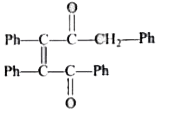CH3−O∣∣C−H and Ph−O∣∣C−H can be differentiated by :
Tollen's reagent
Fehling's solution
Lucas reagent
Victor meyer's test
The correct Answer is:B
To differentiate between acetaldehyde (CH₃CHO) and benzaldehyde (C₆H₅CHO), we can use the Fehling's solution test. Here’s a step-by-step explanation of the process:
1. Understanding the Compounds:
- Acetaldehyde (CH₃CHO) is an aliphatic aldehyde, while benzaldehyde (C₆H₅CHO) is an aromatic aldehyde.
2. Preparation of Fehling's Solution:
- Fehling's solution consists of two solutions: Fehling's A (copper(II) sulfate solution) and Fehling's B (alkaline sodium tartrate solution). Mix equal volumes of these two solutions to prepare Fehling's solution.
3. Testing Acetaldehyde:
- Take a small amount of acetaldehyde and add it to the prepared Fehling's solution.
- Heat the mixture in a water bath.
4. Observation for Acetaldehyde:
- Upon heating, acetaldehyde will reduce the copper(II) ions (Cu²⁺) in Fehling's solution to form cuprous oxide (Cu₂O), which precipitates as a red solid.
- This indicates a positive test for reducing sugars and aldehydes.
5. Testing Benzaldehyde:
- Now, take a small amount of benzaldehyde and add it to another portion of the Fehling's solution.
- Again, heat the mixture in a water bath.
6. Observation for Benzaldehyde:
- Benzaldehyde does not reduce the copper(II) ions in Fehling's solution, so there will be no formation of red precipitate.
- This indicates a negative test for benzaldehyde.
7. Conclusion:
- The presence of a red precipitate indicates the presence of acetaldehyde, while the absence of a precipitate indicates benzaldehyde. Thus, these two aldehydes can be differentiated using Fehling's solution.
- Acetaldehyde (CH₃CHO) is an aliphatic aldehyde, while benzaldehyde (C₆H₅CHO) is an aromatic aldehyde.
2. Preparation of Fehling's Solution:
- Fehling's solution consists of two solutions: Fehling's A (copper(II) sulfate solution) and Fehling's B (alkaline sodium tartrate solution). Mix equal volumes of these two solutions to prepare Fehling's solution.
- Take a small amount of acetaldehyde and add it to the prepared Fehling's solution.
- Heat the mixture in a water bath.
- Upon heating, acetaldehyde will reduce the copper(II) ions (Cu²⁺) in Fehling's solution to form cuprous oxide (Cu₂O), which precipitates as a red solid.
- This indicates a positive test for reducing sugars and aldehydes.
- Now, take a small amount of benzaldehyde and add it to another portion of the Fehling's solution.
- Again, heat the mixture in a water bath.
- Benzaldehyde does not reduce the copper(II) ions in Fehling's solution, so there will be no formation of red precipitate.
- This indicates a negative test for benzaldehyde.
- The presence of a red precipitate indicates the presence of acetaldehyde, while the absence of a precipitate indicates benzaldehyde. Thus, these two aldehydes can be differentiated using Fehling's solution.
Similar Questions
Knowledge Check
- Question 1 - Select One or More
H−O∣∣C−OH and H3C−O∣∣C−OH can be distinguished by:
ANaHCO3BH2SO4CAgNO3/NH4OHDFehling solution - Question 2 - Select One
Arrange the following compounds in decreasing order of nucleophilic addition reaction:
CH3−O∣∣CI−CH3 CH3−O∣∣CII−Cl CH3−O∣∣CIII−NH2 CH3−O∣∣CIV−OH
CH3−O∣∣C−OV−O∣∣C−CH3AII>V>I>IV>IIIBIII>IV>I>V>IICII>I>V>III>IVDI>III>V>I>II - Question 3 - Select One
Find the product of following reaction:
Ph−CH2−O∣∣C−CH2−Ph+Ph−O∣∣C−O∣∣C−PhNaOH−−−−−−→ΔA B
B C
C DNone of these
DNone of these
C12H16(A)O3Zn,H2O2−−−−−−−→2H3C−O∣∣C−CH3+2HOOC−O∣∣C−COOH
What is degree of unsaturation of compound A?View SolutionThe correct order of reactivity of PhMgBr with
Ph−O∣∣CC−Ph(I) CH3−O∣∣C−H(II) CH3−O∣∣C−CH3(III) isView SolutionThe correct order of reactivity of PhMgBr with
Ph−O∣∣CC−Ph(I) CH3−O∣∣C−H(II) CH3−O∣∣C−CH3(III) isView SolutionThe order of stability of the following tautomeric compounds is
(i). CH2=OH∣CH−CH2−O∣∣C−CH3⇔
(ii). CH3−O∣∣C−CH2−O∣∣C−CH3⇔
(iii). CH3−OH∣C=CH−O∣∣C−CH3View SolutionArrange the compounds in order of decreasing reactivity for nucleophilic addition reaction
CH3−O∣∣CI−CH2−Cl Cl−CH2II−O∣∣C−H H−O∣∣CIII−H H3C−O∣∣CIV−CH3View Solution

